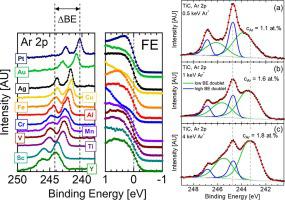Applied Surface Science ( IF 6.7 ) Pub Date : 2023-05-29 , DOI: 10.1016/j.apsusc.2023.157598 G. Greczynski , L. Hultman

|
Correct binding energy (BE) spectra referencing of insulating samples remains the major challenge in modern XPS analyses. Ar 2p signal of implanted Ar is sometimes used for this purpose. The method relies upon the assumption that chemically inert species such as noble gas atoms would be ideally suited as other factors affecting core level peak positions (such as chemical bonding) can be excluded. Here, we present a systematic study on the Ar 2p referencing method applied to a wide range of thin film sample materials of metals, nitrides, carbides, and borides. All specimens exhibit a well-defined Fermi edge, which serves as an independent internal reference for Ar 2p spectra of in-situ implanted Ar. Ar 2p3/2 binding energy is shown to vary by as much as 5.1 eV between samples. This is more than typical chemical shifts of interest, which obviously disqualifies Ar 2p referencing. The BE of the Ar 2p peaks shows a strong correlation to the number of valence electrons available for screening, implying that the polarization energy has a major role for the observed large spread of Ar 2p3/2 BE values. In several cases of single-phase films, an additional Ar 2p doublet is observed with the Ar 2p3/2 BE referenced to the vacuum level higher than the gas phase value of 248.6 eV, which is tentatively assigned to the formation of Ar-N and Ar-C complexes stabilized by Van der Waals forces. Ar implantation into two-phase samples, exemplified here by phase-segregated NiCrC/a-C:H and nanocomposite c-TiN/SiNx thin films, leads to complex Ar 2p spectra, which further demonstrates unreliability of the referencing method. The firm conclusion of the study is that the Ar 2p3/2 peak from implanted Ar is not a remedy for the charge referencing problem.
中文翻译:

关键方法评估反驳了注入 Ar 的 Ar 2p 信号以参考 X 射线光电子能谱
绝缘样品的正确结合能 (BE) 光谱参考仍然是现代 XPS 分析中的主要挑战。注入 Ar 的 Ar 2p 信号有时用于此目的。该方法依赖于这样的假设,即惰性气体原子等化学惰性物质将非常适合,因为可以排除影响核心水平峰位置的其他因素(例如化学键合)。在这里,我们对应用于金属、氮化物、碳化物和硼化物等各种薄膜样品材料的 Ar 2p 参考方法进行了系统研究。所有标本都具有明确的费米边,可作为原位注入 Ar 的 Ar 2p 光谱的独立内部参考。Ar 2p 3/2结合能显示样品之间的差异高达 5.1 eV。这不仅仅是感兴趣的典型化学位移,这显然不符合 Ar 2p 参考的资格。Ar 2p 峰的 BE 显示与可用于筛选的价电子数有很强的相关性,这意味着极化能量对观察到的 Ar 2p 3/2 BE 值的大范围分布具有重要作用。在单相薄膜的几种情况下,使用 Ar 2p 3/2观察到额外的 Ar 2p 双峰BE 指的是高于 248.6 eV 气相值的真空水平,这暂时归因于由范德华力稳定的 Ar-N 和 Ar-C 复合物的形成。Ar 注入两相样品,这里以相分离的 NiCrC/aC:H 和纳米复合 c-TiN/SiN x薄膜为例,导致复杂的 Ar 2p 光谱,这进一步证明了参考方法的不可靠性。该研究的明确结论是,注入 Ar 的 Ar 2p 3/2峰不能解决电荷参考问题。



























 京公网安备 11010802027423号
京公网安备 11010802027423号